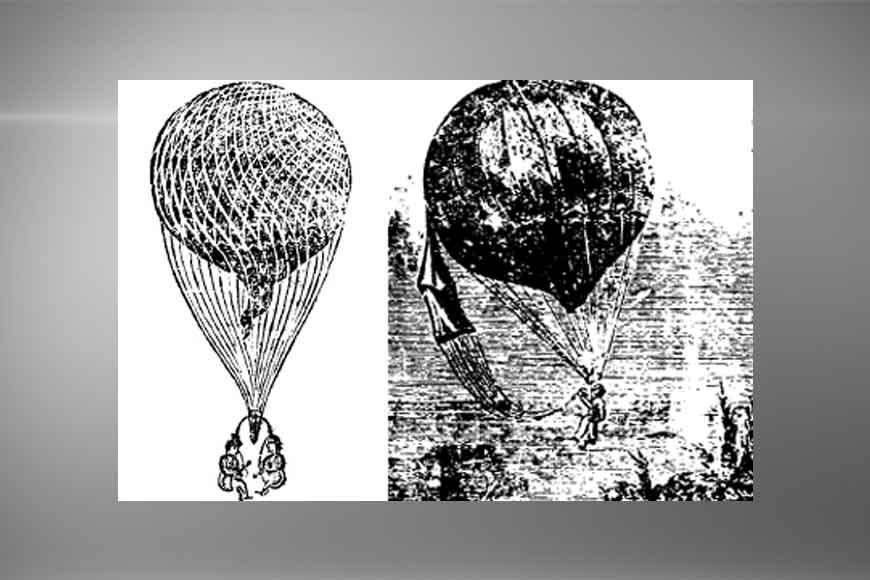First Indian to fly was from Kolkata --- Ramchandra Chatterjee

Remember the award-winning French short film, Red Balloon by Albert Lamorisse, elegantly capturing the adventures of a boy who befriends a seemingly sentient balloon and follows it through the streets of Paris? The vast expanse of the sky has always been synonymous with freedom, fuelling imagination of mankind. Montgolfier Brothers’ invention of the hot-air balloon in December 1783 opened a whole new vista and paved the way for human exploration of the sky. At last, man was able to realize his long-cherished dream of flying like a bird. The balloons immediately aroused passions of scientists, adventurers and acrobats alike.
Ballooning took divergent paths in Britain and France. Instead of being a medium of scientific experiments in Britain, ballooning became a way of showcasing daring skills of acrobats and trapeze artists. These acrobats were leaders of a new profession and some of them soon emerged as great showmen, touring the country and abroad, including Calcutta, the second city of the British Empire, entertaining audiences with their spellbinding feats.
The first balloon flight in India was undertaken on March 16, 1836 by D. Robertson. He took off from a place called Muchikhola in the suburbs of Calcutta (now in Garden Reach). The event attracted huge crowd from Kashipur to Garden Reach. People jostled for space both on land and on boats plying on Ganga River to witness the show. Then in the late 1880s, the famous balloonist Percival Spencer arrived in India, giving balloon demonstrations all over the country. On March 19, 1889, his balloon took off from the Calcutta Race course --- a month later he flew again, this time accompanied by Ramchandra Chatterjee.
Chatterjee’s determination to fly was ignited by events of the time. In early 19th-century, hot-air balloons often dotted the Calcutta skyline and there was no dearth of stunned onlookers. Although in the initial years, ballooning was an exclusive domain of the British and other Europeans, it stoked the spirit of challenge and adventure in ‘natives’ too.
The British in India had the typical colonial outlook towards ‘natives’ and branded Bengalis as ‘low-lying people in low-lying land.’ Since the beginning of the 19th century, the British rebuked their colonial subjects for their “grit of a rabbit” and their physical frailty.
The nationalist movement was still in its nascent stage and the patriots who were trying to sensitize the countrymen, reacted sharply to the stereotypical definition of Bengalis by the British. Many organizations came up for imparting physical fitness training to Bengali youths. The introduction of hot air balloons provided the perfect opportunity to the ‘native Bengalis’ to take up the challenge and prove their mettle as an equally brave, physically fit and mentally alert race as their colonial challengers.
Aeronaut Perceval Spencer’s tour of Calcutta in 1889 provided the right opportunity. His first successful flight in the city was greeted with much fanfare. Gymnast Abatar Chandra Laha met and requested Spencer to accept him as his apprentice. Anil Chandra Banerjee, another aspirant wrote an open letter in the newspaper requesting Spencer to take him under his wings. However, both Laha and Banerjee failed in their endeavor as Spencer ignored appeal. However, it was Laha who introduced Chatterjee to Spencer. Chatterjee lived in Kansaripara in the Shimulia locality of Calcutta. He was already well-known for his gymnastics and trapeze acts after he began his career as an acrobat in Nabagopal Mitra’s National Circus Company.
Chatterjee took his first flight with Spencer. The balloon ascended from the grounds of Oriental Gas Company at Narkeldanga, and after an hour’s journey the it finally descended at a village near Barasat. The historic incident was widely reported in newspapers. Inspired by his joint ascent with Spencer, Chatterjee planned a solo flight in April, for which he purchased Spencer’s balloon “The Viceroy” and renamed it “The City of Calcutta”. All this was expensive business and Chatterjee was supported throughout by the Tagores of Pathuriaghata.
The date of the ascent was fixed for April 27, 1889, and the grounds of the gas company as the venue. The event was widely advertised and tickets were sold for admission, with prices ranging from Rs 3 to 4 annas. But owing to bad weather, the flight was postponed to May 4. On that day, a band played and 8,000 people looked on as Ramchandra, wearing a light suit and a cap, went up on “The City of Calcutta” just after five in the evening. The balloon stayed airborne for nearly 40 minutes and descended at a place near Sodepore. The Nebutala Youngmen’s Club congratulated Chatterjee by saying that even a European would feel proud of his achievement.
Chatterjee’s mission was successful. He proved the colonial assumption wrong and established the fact that ‘native’ Bengalis were indomitable and competent and were undaunted by any challenge.









